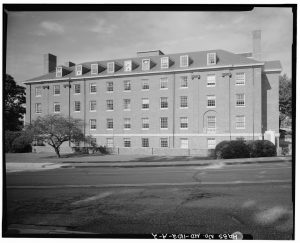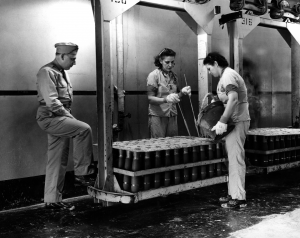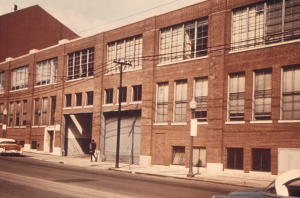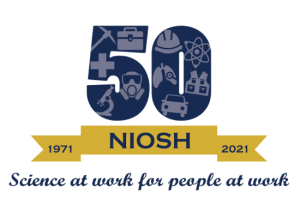The Secret Origins of NIOSH
Posted on by
While NIOSH’s 50th anniversary dates from its creation in its present form in 1971, it has a little-known history that stretches back much farther. NIOSH was in fact created from the Division of Industrial Hygiene of the U.S. Public Health Service, which has a continuous and eventful history going all the way back to 1914. Its path leads from Pittsburgh to D.C. to Bethesda, Maryland, where it was an integral part of NIH’s newly built campus and had a vital role in supporting worker health during World War II. The bulk of its activities then relocated to a converted warehouse in Cincinnati in 1950 (see blog on NIOSH in Cincinnati) as interest in worker health waned, but in the 1960s an effort to build support for a national occupational health program began that eventually led to the creation of NIOSH in 1971.
As part of its 50th anniversary year, NIOSH has been creating Wikipedia articles on historical topics including the Division of Industrial Hygiene, which is presented in condensed form here.
An Early Heyday for Industrial Hygiene

The U.S. Public Health Service (PHS) arose from a loose system of federally funded Marine Hospitals that was founded in 1798 to serve traveling merchant seamen. In 1871, the system was centralized into the new Marine Hospital Service, led by the Surgeon General and staffed by the Commissioned Corps. It was soon given authority over civil quarantines by Congress, and as the 19th century turned into the 20th, its activities expanded further to include disease prevention and basic research. The increase in its functions was so great that in 1912 it changed its name to the Public Health Service.
In this context we begin to see some familiar organizations. A one-room laboratory founded in 1887 in the Marine Hospital on Staten Island would grow to become the National Institute of Health—though it was still singular at the time. The 1912 PHS law expanded its scope from communicable diseases to all “diseases of man”, leading to the establishment of a water pollution research station in Cincinnati that is the earliest predecessor of the EPA, as well as NIOSH’s earliest predecessor, the Office of Industrial Hygiene and Sanitation. Later, in 1946, PHS formed a new Atlanta-based agency built from its WWII-era malaria control programs called the Communicable Disease Center—an agency whose name might not be familiar, but whose initials should be.

Industrial Hygiene established itself in 1914 in the Marine Hospital in Pittsburgh, across town from the Bureau of Mines’ newly established Bruceton Research Center (which would itself become part of NIOSH nearly a century later). Within a few years, Industrial Hygiene moved to Washington, D.C., and during the 1920s it pioneered the development of industrial hygiene as a scientific field integrating both environmental and clinical analysis, with the goal of providing objective, useful technical information. It also facilitated the creation of industrial hygiene units in nearly every state health department.
Industrial Hygiene became a division of NIH in 1937 just as the latter was preparing to construct its new campus in Bethesda, Maryland. One of its first three buildings, today known as Building 2, was the Industrial Hygiene Laboratory, the first laboratory built solely for the study of industrial hygiene in the nation.

Industrial workers were considered to be vital to victory in World War II, leading to increased resources for research and interventions to support their health. Among the Division of Industrial Hygiene’s most successful programs was the prevention of TNT poisoning and other diseases at arsenals and shell loading plants. The Division’s laboratory research activities included toxicological studies, and studies of the health effects of lighting and ventilation. It also developed new analytic methods and instrumentation, including a spectrometer built by Frederick S. Brackett containing two of the largest natural quartz prisms in the world. The period was also marked by a rivalry with the Department of Labor’s Division of Labor Standards, the direct predecessor of OSHA.
The Move to Cincinnati
However, Industrial Hygiene’s future was not to be with NIH. In 1950, its main field activities moved to Cincinnati, while the administrative offices remained in Washington, D.C. By this time, the water pollution research station in Cincinnati had expanded into a series of environmental health divisions covering air, industrial, and chemical pollution and radiological health research. Although the Division of Industrial Hygiene had considered occupying vacant Marine Hospital buildings in various cities, the PHS environmental health divisions had already leased space on the second floor of the warehouse at 1014 Broadway in Downtown Cincinnati, and it was more economical to occupy the rest of the building than to utilize space elsewhere. It would also evolve ever so slightly towards its current name, becoming the Division of Occupational Health.

The Taft Center was originally built for the PHS environmental health divisions in 1954, but the Division of Occupational Health was not invited to join them. There were proposals to build a second building next to Taft for Occupational Health, but these plans did not come to fruition. Rather, the 1950s were a period in which occupational health did not attract national attention as a major concern, and Occupational Health was demoted to become a program of another division. 1014 Broadway would stay its home, and later NIOSH’s, for a quarter century.
The Birth of NIOSH and the CDC Connection
The Division of Occupational Health would reemerge in 1960. During the following decade, there was an effort to build support for a national occupational health program, leading to a report entitled Protecting the Health of Eighty Million Americans—A National Goal for Occupational Health, also known as the Frye Report. It stated that “The Division of Occupational Health has the leadership and skills upon which an effective, imaginative national program can be built… The Division needs only the legislative authority and funds to extend its existing activities and to assume effective responsibility for areas of need identified for many years.” At the same time, President Lyndon B. Johnson took interest in workplace hazards and began integrating the topic into his speeches beginning in May 1966, and in 1968 he would propose the first version of the legislation that would later become the Occupational Safety and Health Act.
However, its passage would not immediately happen. The years between 1966 and 1973 were tumultuous for PHS and its agencies, as they would be subject to almost continuous reorganizations. The Division of Occupational Health would become the Occupational Health Program, then the Bureau of Occupational Safety and Health, and finally NIOSH, passing through seven parent agencies in seven years. The Appalachian Laboratory for Occupational Safety and Health was also founded in Morgantown, West Virginia during this period, while the PHS environmental health divisions were split off to form the core of the new EPA.
At this time CDC was actively trying to expand its scope, which was reflected in its new name of Center for Disease Control—though it was still singular like NIH had been decades before. At the end of the reorganizations in 1973, CDC was promoted to operating agency status, and it absorbed NIOSH the same year, despite the latter actually having the longer history. The transfer was based on the two agencies’ common goal of preventing disease, although NIOSH’s broad range of functions, including research, meant that it would not cleanly fit under any other agency.
In 1976, NIOSH took over the Taft Center and 5555 Ridge Road (now the Alice Hamilton Laboratory) after the EPA moved across town to the new Andrew W. Breidenbach Environmental Research Center. Its move to Taft was intended to be temporary, as there were plans were to build NIOSH a new building next to the Breidenbach Center. However, although two studies had already concluded that NIOSH should stay at a new facility in Cincinnati, Congress forced another reevaluation in hopes of having it move to another city. The new report recommended that NIOSH move to Chicago, which was however rejected by the Department of Health, Education, and Welfare, which determined in 1978 that NIOSH did not require a new facility after all. This made permanent its location in Cincinnati, a situation that lasts to the present day.
 A fuller version of this story is available at the Wikipedia article Division of Industrial Hygiene. A full list of Wikipedia articles on the history of the Division of Industrial Hygiene and the U.S. Public Health Service more broadly, including articles on buildings, people, and related organizations, is available on the NIOSH 50th website. This blog is part of a series for the NIOSH 50th Anniversary.
A fuller version of this story is available at the Wikipedia article Division of Industrial Hygiene. A full list of Wikipedia articles on the history of the Division of Industrial Hygiene and the U.S. Public Health Service more broadly, including articles on buildings, people, and related organizations, is available on the NIOSH 50th website. This blog is part of a series for the NIOSH 50th Anniversary.
John P. Sadowski, Ph.D. is the NIOSH Wikipedian-in-Residence (contractor).
Further Reading
There are three preexisting histories of the Division of Industrial Hygiene. The first two of these were not easily publicly available prior to this project:
- Henry N. Doyle (1977). “The federal industrial hygiene agency: a history of the Division of Occupational Health, United States Public Health Service”.
- Lynne Page Snyder (1998). “The National Institute for Occupational Safety and Health, 1971–1996: a brief history”.
- Lewis J. Cralley (1996). “Historical perspectives: industrial hygiene in the U.S. Public Health Service (1914–1968)”
Several other sources provide additional information:
- Christopher Sellers (1991). “The Public Health Service’s Office of Industrial Hygiene and the transformation of industrial medicine”.
- David Rosner and Gerald Markowitz (1985). “Research Or Advocacy: Federal Occupational Safety And Health Policies During The New Deal”
- Historic American Buildings Survey: NIH Industrial Hygiene Laboratory.
- Michele Lyons (2006). “70 acres of science: The NIH moves to Bethesda”
- (1964). “A Half Century of Service in Occupational Health”
- (1966). “Protecting The Health Of Eighty Million Americans: A National Goal For Occupational Health”
- John A. Breslin (2010). “One Hundred Years of Federal Mining Safety and Health Research”
- Ralph Chester Williams (1951). “The United States Public Health Service, 1798–1950”
- Bess Furman (1973). “A Profile of the United States Public Health Service, 1798–1948”
Posted on by

